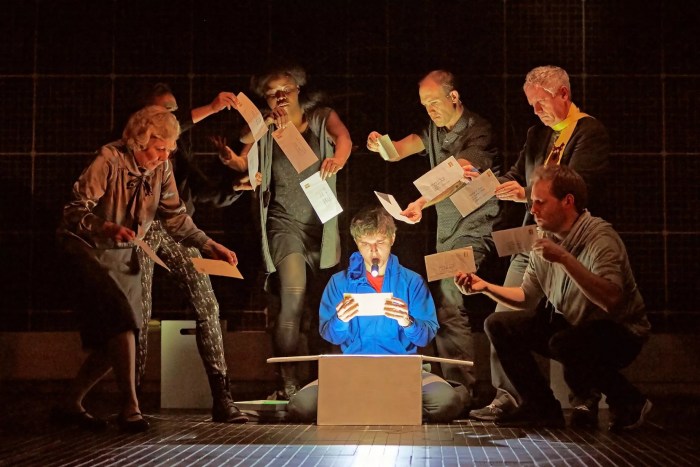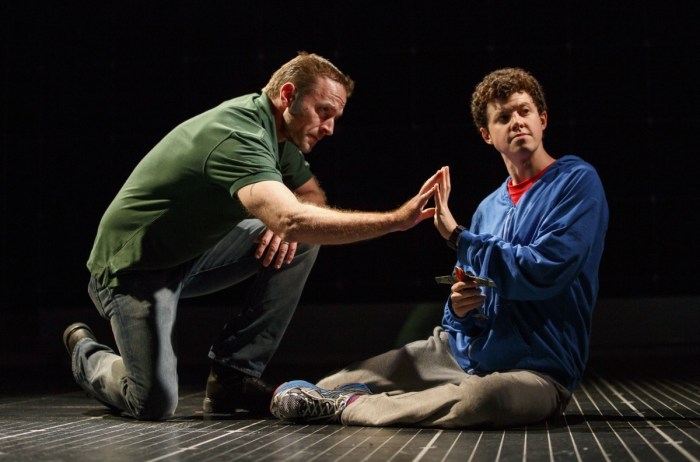The curious incident of the dog in the nighttime characters – Mark Haddon’s award-winning novel, The Curious Incident of the Dog in the Night-Time, invites readers to embark on an extraordinary journey into the mind of an autistic protagonist, Christopher Boone. Through Christopher’s unique perspective, the novel explores profound themes of autism, family dynamics, and the complexities of human relationships.
With its intricate narrative structure, rich symbolism, and unforgettable characters, The Curious Incident of the Dog in the Night-Time offers a poignant and thought-provoking exploration of the human condition.
Character Profiles

The novel’s protagonist, Christopher Boone, is a 15-year-old boy with autism spectrum disorder (ASD). He is highly intelligent, with an exceptional memory and a deep understanding of mathematics and logic. However, he struggles with social interaction and communication, and he often experiences sensory overload and meltdowns.
Supporting Characters
- Ed Boone: Christopher’s father, who is struggling to cope with his son’s autism and his own marital problems.
- Judy Boone: Christopher’s mother, who left the family when he was a child. She is portrayed as a loving and supportive mother, but she is also distant and emotionally unavailable.
- Siobhan: Christopher’s teacher and mentor, who helps him to understand his own emotions and to navigate the complexities of social interaction.
Animals
Animals play an important role in the novel. Wellington the dog is a symbol of Christopher’s innocence and vulnerability. He is the only creature who can truly understand Christopher and provide him with unconditional love.
Narrative Structure and Perspective: The Curious Incident Of The Dog In The Nighttime Characters

The novel is written in the first-person narrative from Christopher’s perspective. This gives the reader a unique insight into his mind and experiences. The novel is structured as a mystery, with Christopher investigating the death of Wellington the dog. The investigation leads him on a journey of self-discovery and a deeper understanding of the world around him.
Significance of the “Incident”
The “incident” referred to in the title is the death of Wellington the dog. This event is a catalyst for Christopher’s journey of self-discovery. It forces him to confront his fears and to learn to cope with the complexities of the world.
Structure of the Novel
The novel is structured into three parts. The first part introduces Christopher and his world. The second part follows his investigation into the death of Wellington the dog. The third part resolves the mystery and provides a sense of closure for Christopher.
Themes and Symbolism
Major Themes
- Autism: The novel explores the challenges and experiences of living with autism. It provides a unique insight into the mind of an autistic individual and challenges stereotypes about autism.
- Family Relationships: The novel explores the complex and often strained relationships between family members. It examines the challenges of parenting a child with autism and the impact of divorce on children.
- The Search for Truth: The novel follows Christopher’s journey to uncover the truth about the death of Wellington the dog. This journey is a metaphor for the search for truth in a world that is often confusing and unpredictable.
Symbolism
The novel uses a number of symbols to explore its themes. The red wheelbarrow is a symbol of Christopher’s innocence and vulnerability. The railway line is a symbol of his journey of self-discovery. Mathematics and logic are symbols of Christopher’s need for order and predictability in a chaotic world.
Literary Devices and Style
Unique Writing Style
The novel is written in a unique and distinctive style that reflects Christopher’s unique perspective. The prose is simple and straightforward, with a focus on concrete details and logical reasoning. The novel also includes a number of illustrations and diagrams that help to visualize Christopher’s world.
Literary Devices, The curious incident of the dog in the nighttime characters
The novel uses a number of literary devices to create a vivid and engaging narrative. These devices include metaphors, similes, and foreshadowing. The novel also uses humor to lighten the mood and to make Christopher’s experiences more relatable.
Format
The novel’s format is also unique and innovative. The novel is divided into short chapters, each of which focuses on a specific topic or event. The novel also includes a number of interludes that provide additional information about Christopher’s world.
Social and Cultural Context

Portrayal of Autism
The novel’s portrayal of autism has been praised for its accuracy and sensitivity. The novel provides a unique insight into the mind of an autistic individual and challenges stereotypes about autism. The novel has also helped to raise awareness of autism and its impact on families.
Family Dynamics
The novel also explores the complex and often strained relationships between family members. The novel examines the challenges of parenting a child with autism and the impact of divorce on children. The novel provides a realistic and nuanced portrayal of family life.
Cultural References
The novel also includes a number of cultural references and allusions. These references help to situate the novel in its historical and cultural context. The novel also explores the impact of popular culture on Christopher’s life.
FAQ Resource
What is the main theme of The Curious Incident of the Dog in the Night-Time?
The novel explores the challenges and triumphs of living with autism, highlighting the importance of acceptance, understanding, and empathy.
How does Christopher’s autism shape his perspective on the world?
Christopher’s autism affects his perception of social cues, his reliance on logic and routine, and his difficulty understanding emotions.
What is the significance of the dog in the novel’s title?
The dog, Wellington, represents the mystery that Christopher sets out to solve, as well as the catalyst for his journey of self-discovery.